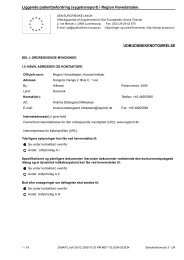Territorial Review Copenhagen - Region Hovedstaden
Territorial Review Copenhagen - Region Hovedstaden
Territorial Review Copenhagen - Region Hovedstaden
Create successful ePaper yourself
Turn your PDF publications into a flip-book with our unique Google optimized e-Paper software.
139<br />
a number of industrial research networks, their effect on the regional<br />
innovation system of the region was found to be very limited, partly because<br />
their design was complicated and not well adapted to regional circumstances<br />
(Faugert et al., 2004). Possible avenues to explore might be collaboration<br />
between the Øresund University and Øresund <strong>Region</strong> on a common strategy<br />
for university-industry co-operation, for example by streamlining the<br />
activities of the different science parks. Better clustering of similar start-ups<br />
could arguably stimulate further integration of research activities and<br />
rationalise duplications.<br />
Research funding<br />
Innovation in metropolitan areas is influenced by the quality of research,<br />
and research funding is of critical importance. Denmark has a two-tier<br />
system for resource allocation for research. The first tier is the basic grant,<br />
allocated by the different ministries directly to the institutions. The second<br />
tier includes resource allocation from the National Research Councils,<br />
strategic research programmes, R&D funds from the different ministries,<br />
private funds and firms. The basic research grant is allocated as a lump sum<br />
to the institutions and to a large extent calculated on an incremental basis.<br />
Basic grants are not dedicated to specific activities; distribution of the grants<br />
is relatively permanent and based on precedent. New research grants to<br />
universities are increasingly distributed according to models relying on<br />
activity parameters. An essential part of the second tier is the research<br />
council system, in which several research councils subsidise research: more<br />
―bottom up‖ research is being subsidised by the Danish Research Council<br />
for Independent Research, governed by researchers, and the independent<br />
Danish National Research Foundation. Top-down, politically prioritised<br />
funding is implemented by the Danish Council for Strategic Research,<br />
governed mainly by private sector members. In addition to the universities‘<br />
research activities, 11 applied research institutes in Denmark (GTS<br />
institutes) play an important role in research, employing a total of 3 000<br />
people and with a turnover of around DKK 2.4 billion. About 11% of their<br />
income comes from performance contracts with the Board for Technological<br />
Service. The other 89% of income comes primarily from industry.<br />
The first tier funding of research lacks incentives for efficiency and the<br />
second tier is not transparent. Although the basic research grants can secure<br />
long-term planning of universities, they appear to lack incentives for<br />
efficiency, relevance and societal impact. As they are mostly based on<br />
historical allocations, no mechanisms are in place to ensure that the<br />
institutions producing the highest quality of research are rewarded. Although<br />
the second tier provides a multi-faceted perspective on research priorities, it<br />
represents complicated arrangements that can easily become opaque and

















